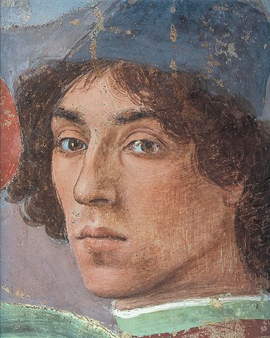


Filippino Lippi was the son of the famous painter Filippo Lippi and came from his illegitimate relationship with the nun Lucrezia Bruti. Actually Filippino had the same first name as his father and was only known under this name during his lifetime. Researchers in art history later gave him the name Filippino, i.e. little Filippo, in order to distinguish him better from his father. The young Lippi began his education first under the guidance of his father. They moved from Prato to Spoleto, where Lippi the Elder was commissioned to produce the frescoes for the newly built cathedral there. Filippino supported his father in this and completed the work alone after his death in 1469. Afterwards Lippi was apprenticed by a friend of his father Fra Don Diamante and was finally employed by his father's former student Sandro Botticelli in his studio around 1472. The greatest influence on Filippino Lippi's work was his father and Botticelli.
Lippi was highly regarded during his lifetime especially for his fresco painting. During his career he received many commissions in Florence and Rome. He decorated numerous churches and chapels, but the Florentine nobility was also among his clientele. Lorenzo de Medici, for example, commissioned him, together with Botticelli, Perugino and Ghirlandaio to complete the fresco decoration of his villa in Spedaletto. Among Lippi's most famous works today are "Vision of St. Bernard", "The Adoration of the Kings" or the "Mystical Marriage of St. Catherine". They all probably date from his later phase, that is, after 1480, because while his earlier works, which he signed only with "Friend of Sandro" (Botticelli), were still very reminiscent of his style, between 1480-1485 he began to develop his own, much harder and more effective style. After finishing the Carafa Chapel in Rome, which became one of his most important fresco decorations, he returned to his native Florence and worked only in this region until his death.
Filippino Lippi married around 1497 Maddalena the Piero Paolo Monti, with whom he had 3 sons. Among his contemporaries Lippi was very popular. They praised his polite, sensitive, but at the same time humorous manner. He died at the age of 47 from the consequences of an acute sore throat. The appreciation for him as an artist was so great that on the day of his funeral the workshops in Florence were closed. But after his death Lippi was soon forgotten. This was not least due to the fact that the next generation of great famous Italian painters such as Raffael and Michelangelo were already emerging. Today, Lippi is regarded by art historians as an important link between the early and high Renaissance and is considered one of the pioneers of Mannerism. One of his most important students is Raffaellino del Garbo.

Filippino Lippi was the son of the famous painter Filippo Lippi and came from his illegitimate relationship with the nun Lucrezia Bruti. Actually Filippino had the same first name as his father and was only known under this name during his lifetime. Researchers in art history later gave him the name Filippino, i.e. little Filippo, in order to distinguish him better from his father. The young Lippi began his education first under the guidance of his father. They moved from Prato to Spoleto, where Lippi the Elder was commissioned to produce the frescoes for the newly built cathedral there. Filippino supported his father in this and completed the work alone after his death in 1469. Afterwards Lippi was apprenticed by a friend of his father Fra Don Diamante and was finally employed by his father's former student Sandro Botticelli in his studio around 1472. The greatest influence on Filippino Lippi's work was his father and Botticelli.
Lippi was highly regarded during his lifetime especially for his fresco painting. During his career he received many commissions in Florence and Rome. He decorated numerous churches and chapels, but the Florentine nobility was also among his clientele. Lorenzo de Medici, for example, commissioned him, together with Botticelli, Perugino and Ghirlandaio to complete the fresco decoration of his villa in Spedaletto. Among Lippi's most famous works today are "Vision of St. Bernard", "The Adoration of the Kings" or the "Mystical Marriage of St. Catherine". They all probably date from his later phase, that is, after 1480, because while his earlier works, which he signed only with "Friend of Sandro" (Botticelli), were still very reminiscent of his style, between 1480-1485 he began to develop his own, much harder and more effective style. After finishing the Carafa Chapel in Rome, which became one of his most important fresco decorations, he returned to his native Florence and worked only in this region until his death.
Filippino Lippi married around 1497 Maddalena the Piero Paolo Monti, with whom he had 3 sons. Among his contemporaries Lippi was very popular. They praised his polite, sensitive, but at the same time humorous manner. He died at the age of 47 from the consequences of an acute sore throat. The appreciation for him as an artist was so great that on the day of his funeral the workshops in Florence were closed. But after his death Lippi was soon forgotten. This was not least due to the fact that the next generation of great famous Italian painters such as Raffael and Michelangelo were already emerging. Today, Lippi is regarded by art historians as an important link between the early and high Renaissance and is considered one of the pioneers of Mannerism. One of his most important students is Raffaellino del Garbo.
Page 1 / 3








